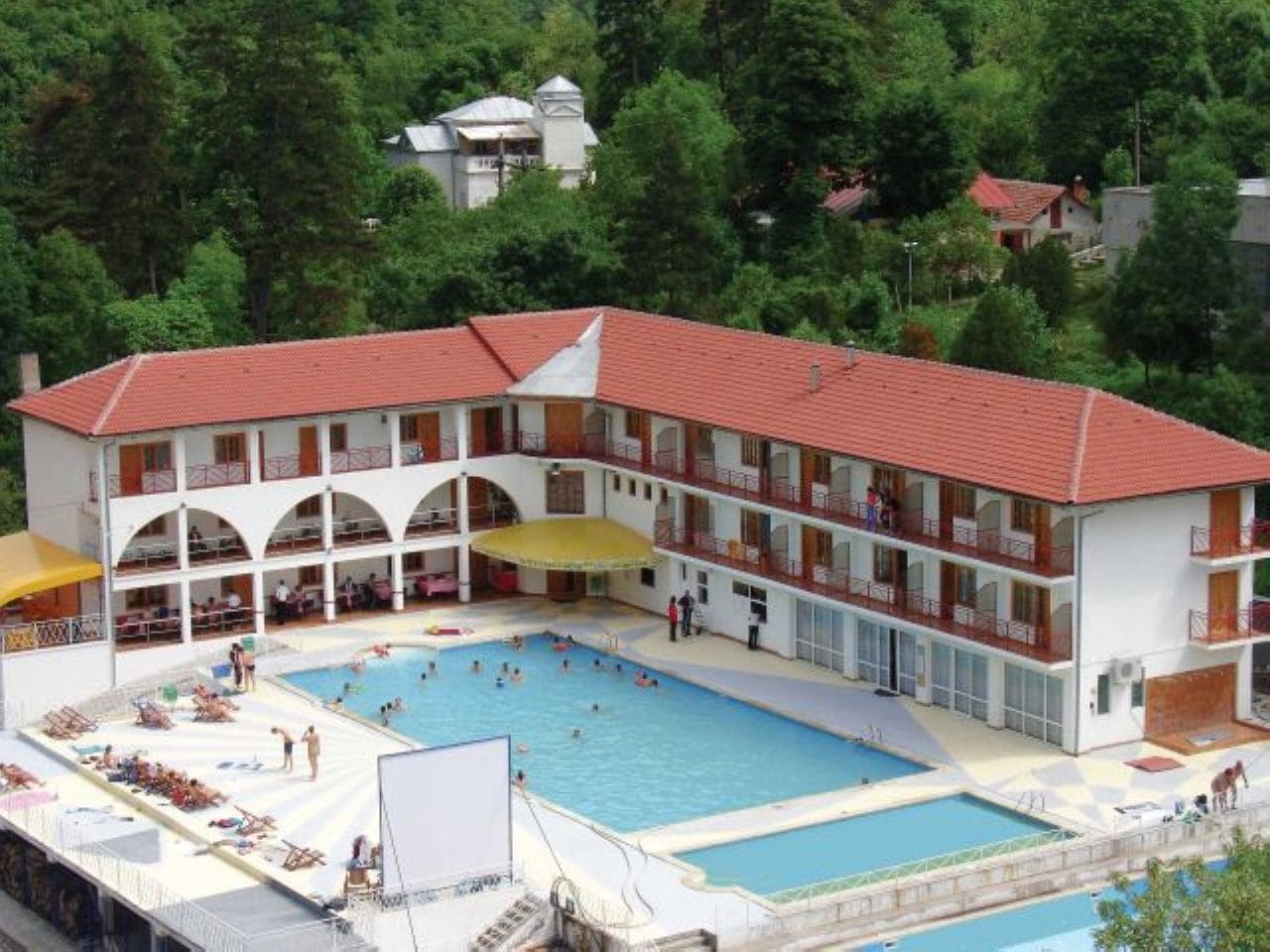Ah Romania, land of vampires, werewolves, castles, and… dank hot springs. That’s right, Romania is home to some of the best hot springs in Europe. Even the ancient Romans flocked to Romania’s oldest hot spring towns to bask in the mineral-rich thermal water found in the country’s many popular hot springs.
For the uninitiated, hot springs are essentially man-made swimming pools filled with thermal water which circulates through the pools throughout the day. Think a giant jacuzzi filled with natural water that’s being pumped from deep underground.
Many people visit hot springs for the healing properties of their mineral-packed waters. Proponents of their health benefits claim that the waters are useful in curing a range of diseases from eczema to kidney stones.
Even if you’re not trying to shake a bad case of eczema, there are still ample reasons why you should add a stop at one (or more) of Romania’s famed hot springs to your itinerary:
- Do as the Roman(ian)s do. Romanians, especially the older generations, love hot springs. During the country’s Socialist period, traveling outside of the country was rare, if not impossible. So, most Romanians spent their vacations lounging around at one of the country’s great hot spring resorts. In fact, Romania’s hot spring scene boomed during this period and attracted tourists from all over Romania and even the Soviet Union. Since the collapse of Communism in Romania and the opening of the country’s borders to the European Union, however, most hot spring towns in Romania have been reduced to a sliver of their former glory. Nevertheless, a visit to one of Romania’s hot springs will provide you a glimpse into a uniquely Romanian form of recreation.
- Cool Down during Romania’s blistering Summers. Romanian Summers can be scorching, especially in the low-lying areas around Bucharest, the country’s capital. Like any good Europeans, Romanians seldom use air conditioning, so taking a holiday in the country’s cooler mountainous regions is common. During the summer, the country’s hot springs come alive and are filled with local tourists. Since most hot springs do not heat their waters in the Summer, you’ll find that visiting the hot springs is a great way to cool down and escape the heat.
- Warm up during Romania’s frigid Winters. My favorite time to visit Romania’s hot springs is during the Winter. The hot spring towns aren’t as crowded during this season, so you’ll have more room to stretch out and do your creepy yoga poses in the spring’s boiling mineral waters. Namaste. You’ll want to verify that the hot spring you visit is open before you go, however, since many are closed during the winter.
By this point, I hope I’ve convinced you to take a pit stop at one of Romania’s hot springs during your visit to this unique part of the world. If so, then read on to see which hot springs are considered the 10 best hot springs in Romania.
1. Herculean Baths (Băile Herculane)
The Herculean Baths represent the oldest mineral water baths in Romania and some of the oldest in the world. The first mention of the baths was by the Romans in the year 153 AD. The pools of the Herculean Baths are kept at temperatures between 38 and 53 degrees Celsius, while some are kept between 46 and 56 degrees Celsius. The baths themselves are located in Caras Severin County in the Cerna Valley and are part of a Cerna-Domogled Valley National Park.
The primary therapeutic property of the baths is the high content of sulfur, iodine, bromine, bicarbonate, thermo-minerals and sodium chloride found in its waters. All of these minerals are claimed to possess curative properties for diseases of the skin, as well as a number of internal diseases.
Typically, the waters are sought for their supposedly curative properties in treating skin conditions, diseases of the peripheral nervous system, and heavy metal toxicity.
2. Călimanești – Căciulata
Calimanesti is the most beautiful of the hot springs found in Romania’s Olt Valley. Like others on this list, it is known for the therapeutic effects of its mineral waters, its preferable bioclimate, and its proximity to a multitude of tourist activities. Interestingly, Napoleon III of France sought the waters of this spring for their beneficial properties. The baths are situated just 18km north of Ramnicu Valcea, a medium sized city in the Carpathian-Transylvanian region.
The natural healing properties of the mineral waters are owed to its high content of minerals such as: sulfur, chlorate, bromide, sodium, calcium, and magnesium. Its unique mineral content is allegedly useful in treating a number of diseases, including: afflictions of the gastro-intestinal tract, conditions of the renal glands, diseases of the urinary tract, and many others.
3. Vatra Dornei
Nicknamed the Pearl of Bucovina (Bucovina being the Mountainous region to Romania’s North-East), Vatra Dornei is situated just 105km from Suceava, a traditional Bucovinan town. The waters found here are mostly gaseous, slightly bicarbonated, sodium-rich mineral waters. Vatra Dornei is also known for its mud bath therapies with mud imported from Poiana Stampei, in the nearby Carpathians.
The mineral waters at Vatra Dornei are allegedly useful in curing a number of diseases, including: degenerative arthritic diseases, post traumatic nervous disorders, diseases of the nervous system, endocrinological deseases, and gynecological conditions.
4. Sovata
Sovata is located just 15km from Targu Mures, a picturesque town in Romania’s Eastern Carpathian region. Sovata was first hailed for its curative waters in 1597. The baths’ reputation owes itself to its many lakes which contain chloridic and sodium-rich waters. Red lake (lacul rosu), for example, is formed on a salt deposit which radiates heath throughout the lake during the Summer according to solar penetration at the lake’s surface. At the lake’s most extreme depths, the water reaches extreme heats of upwards of 60 degrees Celsius.
The mineral waters at Sovata are purported to alleviate the following ailments: gynecological diseases, degenerative arthritis, inflammation, and diseases of the endocrine system.
5. Băile Felix (Felix Baths)
The Felix baths, located in the country’s northwestern Transylvania region, are situated at an altitude of 140m where the hills meet the mountains of the Crai Forest. The primary attribute of the Felix Baths is the high temperature of its thermal waters which have reached 50 degrees Celsius. For this reason, the Felix baths can be visited year-round for open air treatments.
The primary curative properties of the water are owed to its water which is high in bicarbonate, calcium, siliconium, and sulfur. The area is distinguished by its calming environment and unique mud bath treatments.
6. Băile Tușnad
The waters of Tusnad, located at the foot of Ciomatu Mountain, is distinguished by its proximity to Saint Ana, the only volcanic lake in all of Europe. The lake can be visited by hiking through the mountains for about an hour. The air and mineral water found at this location are alleged to improve cardiovascular conditions and hypertension.
7. Băile Govora
Located in northeastern Valcea county, the Govora Baths are known for being one of the most iodide- and bromide-rich waters in all of Europe. The baths’ name, Govora, comes from the Daco-Thracian word for a valley with many springs.
The waters here are purportedly useful in treating respiratory, arthritic, and neurological diseases.
8. Borsec
Borsec shares its name with a famous Romanian brand of mineral watter–Borsec. The Borsec hot springs are unique in that they are open all year long and are distinguished by the high quality of their mineral waters. In its heyday, Borsec was considered the most luxurious of all of the Romanian hot springs and welcomed tourists from all over Europe.
To this day, Borsec maintains its promise as an appealing tourist destination and efforts are underway to revive its glory days. Its waters are especially well-known for their potential in treating cardiovascular disease, such as weak heart and hypertension.
Borsec’s waters have received distinguished awards several times at Europe’s most prestigious mineral water exhibitions. In addition, the zone of the baths is full of tourist activities and recreational opportunities.
9. Techirghiol
Located in Constanta County on Romania’s Black Sea Coast, Techirgiol is known for the healing property of its mud baths. The city itself is sprawled out around Lake Techirghiol, just 16km from Constanta.
Lake Techirghiol is known for its salted waters and organic matter mud used in a number of therapeutic treatments. Its mud has potential healing benefits for the following afflictions: degenerative rheumatism, diseases of the nervous system, gynecological diseases, and skin diseases.
10. Băile 1 Mai
The baths of 1 Mai are located just 4km outside of Oradea and a mere 2km from the Felix Baths. The spring waters are known for their mineral water and mud baths with mud sourced from the local lake.
At the baths of 1 Mai, you will also find the summer pool complex, Venus. This gargantuan pool complex has the capacity to handle a few thousand bathers at a time. It consists of a number of pools, including an olympic swimming pool, a wave pool, and one equipped with diving boards.
The Best Hot Springs in Romania?
Hopefully I’ve convinced you to visit one of Romania’s great hot springs as part of your visit! The best hot springs for your trip will depend on a number of factors, including the season of your visit and the city you’ll be staying in.
If I had to choose, though, I would probably designate the baths at 1 Mai the best hot springs in Romania. Their close proximity to Oradea and the Venus pool complex make this the ideal place to relax and enjoy Romania’s beautiful natural atmosphere.

